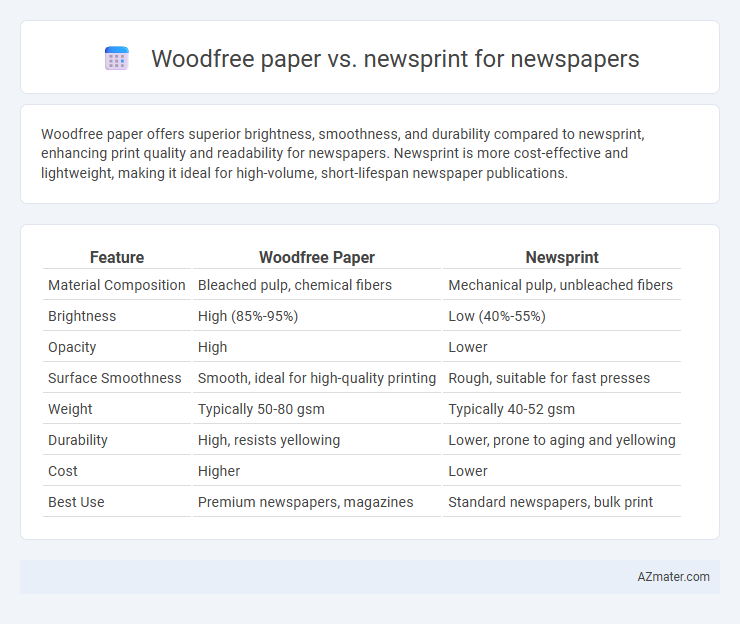Woodfree paper offers superior brightness, smoothness, and durability compared to newsprint, enhancing print quality and readability for newspapers. Newsprint is more cost-effective and lightweight, making it ideal for high-volume, short-lifespan newspaper publications.
Table of Comparison
| Feature | Woodfree Paper | Newsprint |
|---|---|---|
| Material Composition | Bleached pulp, chemical fibers | Mechanical pulp, unbleached fibers |
| Brightness | High (85%-95%) | Low (40%-55%) |
| Opacity | High | Lower |
| Surface Smoothness | Smooth, ideal for high-quality printing | Rough, suitable for fast presses |
| Weight | Typically 50-80 gsm | Typically 40-52 gsm |
| Durability | High, resists yellowing | Lower, prone to aging and yellowing |
| Cost | Higher | Lower |
| Best Use | Premium newspapers, magazines | Standard newspapers, bulk print |
Introduction to Newspaper Paper Types
Woodfree paper, characterized by its high-quality, chemical pulp content without mechanical fibers, offers superior brightness and smoothness ideal for sharp text and vibrant images in newspapers. Newsprint, primarily made from mechanical pulp with lower brightness and durability, is cost-effective and commonly used for mass-circulation newspapers requiring fast production and economical printing. Choosing between woodfree paper and newsprint hinges on print quality demands, budget constraints, and publication lifespan considerations.
What is Woodfree Paper?
Woodfree paper is a high-quality, chemically processed paper made primarily from bleached wood pulp, featuring minimal lignin content that enhances brightness and durability compared to newsprint. It offers a smoother surface and better print definition, making it ideal for newspapers requiring sharp images and vibrant colors. Unlike newsprint, which is cheaper and more porous, woodfree paper provides superior resistance to yellowing and longer-lasting print quality.
Understanding Newsprint Paper
Newsprint paper, typically made from mechanical wood pulp, contains higher lignin content than woodfree paper, resulting in a lower brightness and reduced longevity but offering cost-efficiency critical for mass newspaper production. Woodfree paper, free of mechanical pulp and lignin, provides superior print quality and durability but is less commonly used for newspapers due to higher production costs. Understanding newsprint paper's economy and recyclability makes it the preferred choice for daily newspapers despite its lower archival quality.
Key Differences Between Woodfree and Newsprint
Woodfree paper features a higher quality pulp with minimal lignin content, resulting in a smoother, brighter surface ideal for high-resolution printing and better durability in newspapers. Newsprint primarily uses mechanical pulp containing more lignin, producing a lower-cost, more absorbent paper that tends to yellow and degrade faster. Key differences include woodfree's superior print clarity and longevity versus newsprint's economical production and suitability for short-life publications like daily newspapers.
Print Quality: Woodfree vs Newsprint
Woodfree paper offers superior print quality for newspapers due to its smooth surface and higher opacity, resulting in sharper text and more vibrant images compared to newsprint. Newsprint, made from lower-grade wood pulp, tends to have coarser texture and higher absorbency, which can cause ink spread and reduced clarity. The enhanced brightness and smoother finish of woodfree paper improve color reproduction and readability, making it a preferred choice for premium newspaper editions.
Durability and Longevity Comparison
Woodfree paper offers significantly higher durability and longevity compared to newsprint, primarily due to its chemical pulp composition that results in fewer lignin residues prone to yellowing and degradation. Newsprint, made from mechanically pulped wood fibers, contains more lignin, causing it to deteriorate faster and become brittle over time, especially when exposed to light and air. As a result, woodfree paper is preferred for archival-quality newspapers and printed materials requiring extended preservation.
Environmental Impact of Both Papers
Woodfree paper, primarily composed of chemically bleached pulp, generally has a higher environmental impact due to energy-intensive processing and potential chemical use, but it offers better recyclability and print quality. Newsprint, made from mechanical pulp with minimal chemical treatment, consumes less energy during production but has lower recyclability and often results in faster degradation, contributing to more frequent waste. Both papers present trade-offs in sustainability, with woodfree paper favoring recyclability and newsprint reducing initial resource consumption.
Cost Considerations for Publishers
Woodfree paper, characterized by its higher production costs due to chemical pulping and bleaching processes, demands greater investment from publishers compared to newsprint, which is made from mechanical pulp and remains more economical. Newsprint's lower price per ton makes it the preferred choice for high-volume newspaper printing, balancing cost efficiency with acceptable print quality. Publishers aiming to optimize budgets often select newsprint to reduce material expenses without significantly compromising readability and print clarity.
Reader Experience and Visual Appeal
Woodfree paper offers a smoother surface and higher brightness, enhancing print clarity and color vibrancy for a more engaging reader experience. Newsprint, being more porous and lower in brightness, tends to produce less sharp images and muted colors, impacting visual appeal negatively. The choice of woodfree paper significantly improves readability and aesthetic quality, making it ideal for newspapers aiming for premium presentation.
Choosing the Right Paper for Your Newspaper
Woodfree paper offers superior print quality and durability due to its higher wood pulp content and bleaching process, making it ideal for newspapers aiming for crisp images and longer shelf life. Newsprint, composed primarily of recycled fibers and mechanical pulp, is more cost-effective and suited for high-volume, short-term publications where affordability outweighs longevity. Selecting the right paper depends on balancing print clarity, budget constraints, and the intended lifespan of the newspaper.

Infographic: Woodfree paper vs Newsprint for Newspaper
 azmater.com
azmater.com